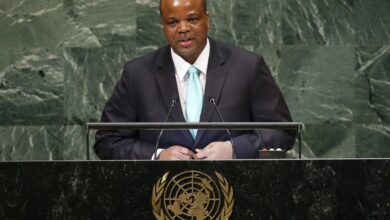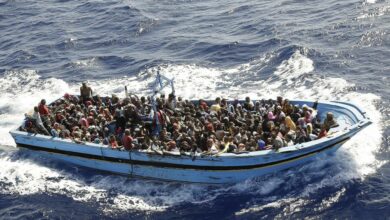Eswatini
Eswatini in long form the kingdom of Eswatini since 2018, sometimes written eSwatini according to the spelling swati formerly kingdom of Swaziland, in swati eSwatini and Umbuso we Swatini, in English Eswatini (ex-Swaziland) and Kingdom of Eswatini, sometimes called Ngwane or Ngwané, is a country in southern Africa without access to the sea, bordered by South Africa and Mozambique. This nation, like its inhabitants, owes its name to the 19th century king Mswati II, a chief whose name means “stick of command” in Zulu. Eswatini is a small country, with less than 200 km separating the north from the south and 130 km east from the west. The western part of the country is in altitude, the altitude is less important towards the center. The eastern border of the country stands out thanks to the Lebombo mountains. The climate is fairly temperate in the west, but it reaches 40 ° C in the east of the country in summer. The country experiences significant rainfall in the west and especially in summer. The territory of present-day Eswatini has been regularly inhabited since prehistoric times, but the plateaux were sparsely populated when the Dlamini (from the Nguni people) found refuge there. Nowadays, these inhabitants almost all belong to the Swazin ethnic group, whose language is Swati.
Eswatini’s history
Although remains of human occupations dating back over 100,000 years have been found in Eswatini, the current population, made up of pastors, settled there only in the 19th century, in the highlands, as part of the wars between the Ndwandwe and the Ngwane. A war opposed, in 1815, the Ngwane-Dlamini of king Sobhuza I to the Ndwandwe led by Zwide. In conflict over the lands of the Pongola valley, Zwide pushes the Ngwane north; they take refuge on the highlands of what will become the Eswatini. When Sobhuza died, his son Mswazi (or Mswati) succeeded him; It was at this time that the Ngwane-Dlamini people took the name of Swazi. A little later, the first whites begin to enter this region. After the Second Boer War, the Eswatini became a British colony.
Independence is granted to the country on September 6, 1968. It is Sobhuza II who is at the head of this monarchy: from supreme chief of the Swazis during the British domination, he became king. Eswatini remains a member of the Commonwealth and joins the United Nations. In April 1973, judging the constitution drawn up by the British, and making this country a constitutional monarchy, in inadequacy with the Swazi traditions, Sobhuza II dissolves the parliament (Libandla) elected, and abolishes this Constitution, leaning to do this on a private army he secretly trained and equipped. This allows him to assume full powers. From this moment, political parties are banned. The Eswatini became an absolute monarchy de facto since 1973 and de jure since 1978. He died in August 1982. The Liqoqo (Royal Interior Council) then appointed Dzeliwe, one of his wives among seventy, as regent queen, due to a priori of his level of education, until a prince other than his son, Prince Makhosetive, designated by the Royal Council as successor, has reached the age of twenty-two. It was the starting point for a period of intrigue within the Court, also with the influence of foreign powers, notably neighboring South Africa. Finally, she was pushed, by the same council, to renounce the regency in favor of Ntfombi Tfwala, the mother of the crown prince Makhosetive.
The crown prince became king, under the name of Mswati III in 1986. He was the last absolute monarch on the African continent, resting his power on traditions. He appoints the Prime Minister, the ministers, the judges, and a part of the parliamentarians, another part being however elected. There are legislative elections to elect 55 of the 65 deputies. To apply, a candidate must raise his hand during an assembly of all the inhabitants of the region, and wait until fifteen people are lining up behind him, in the presence of the chief, to validate his registration. Political parties are prohibited. In addition, every year, at the end of August, all parents must ensure that their still virgin daughters take part in the reed dance, which takes place in front of the king. It is an opportunity for him to possibly choose a new wife (he has about fifteen). On April 19, 2018, King Mswati III announced that the country reverted to its original pre-colonization name: eSwatini for the 50th anniversary of the country’s independence. eSwatini meaning Swazi country in the Swati language, Swaziland was therefore a hybrid name between English and the national language. King Mswati III said “We were the only country in Africa to have kept its name from the colonial era.”
Eswatini’s politics
The current constitution prohibits political parties. On August 18, 2004, King Mswati III announced that the country would change its constitution. Human rights organizations and opposition groups denounced the proposed draft constitution, since it continued to ban political parties and strengthened the powers of the king. Despite resistance from opposition groups, Swaziland’s new constitution was ratified by the king on July 26, 2005 and came into force on February 8, 2006. The country remains an absolute monarchy. Political parties are seen only as associations and the Supreme Court cannot judge cases that may involve the monarchy. In September 2018, the country remains the last African country to be Taiwan’s ally, while all the other countries of the continent support the People’s Republic of China.
Eswatini’s economy
The economy of Eswatini is characterized by an unemployment rate of 34%, that is to say the 170th world rank in 2004. Exports which represent an inflow of money of more than 900 million dollars do not cover the cost of imports, which represent more than a billion dollars. The trade balance is in deficit by 72 million dollars. In 2001, GNP was $ 1.4 billion. Growth of 1.6% in 2001 and 2% in 2006. Production is mainly agricultural. The primary sector employs 80% of the workforce but represents only 16.4% of the GNP. The country grows sugar cane, cotton, tobacco, rice and corn. Since the 1980s, the industry has been developing, particularly in the food and textiles industries. Service activity reaches more than 40% of GNP. The cultivation of sugar cane, the country’s main resource, enslaves a part of the population: forced evictions from rural communities to set up plantations, child labor, weeks of work of up to 60 hours, etc. The International Trade Union Confederation mentions “arduous and unhealthy working conditions, miserable wages and a violent repression of any attempt to organize”.
The economy of Eswatini depends in part on trade with South Africa, its neighbor, and those with Europe. In 2006, imports from South Africa represented 9/10 of total imports and exports to that country 3/4 of exports. The European Union is its second trading partner with 14.2% of exports. Trade with the EU has strengthened since the signing of an economic partnership in 2016. The manufactured products are all imported from South Africa but iron ore, kaolin, wood, sugar are exported to England or in Japan. Foreign companies established in the country, such as Coca-Cola, benefit from a very low tax rate.
Eswatini faces major development challenges. The country is 125th in the world for HDI, despite international aid in 2001 of 104 million dollars. Two thirds of the inhabitants live below the poverty line31. At the same time, 10% of the population holds 50% of the country’s wealth. The difficulties are real in state spending: the budget deficit reached 101 million dollars in 2003. Inflation reached 7.3% compared to that of Namibia. Public services are very underdeveloped: the country has only twelve public ambulances, primary schools generally no longer provide the canteen and pharmacies are disappearing. An economic circle of 15,000 business people takes most of the country’s wealth. This circle includes South African investors who came to find at Eswatini three times cheaper labor and a group of white businessmen heirs to the British settlers. The currency of Eswatini is the lilangeni (7.67 emalangeni for 1 dollar in 2009, approx. 12 for 1 dollar and 14.5 for 1 euro in 2018). The sums allocated to King Mswati III for his official expenses represent 8% of the national budget. The police force receives 5% of the budget, as does the armed forces.
Eswatini’s demography
In 2016, the population of Eswatini is estimated at 1,451,428 inhabitants.
Eswatini is one of the countries in the world with the lowest life expectancy (51.6 years, 2016 estimate), mainly because it is the country in the world where the prevalence rate among adults in HIV / AIDS is the highest, at 25.9%. Eswatini has the 31st highest infant mortality rate in the world (59.57 ‰, 2012 estimate).
Eswatini’s language
Eswatini has two official languages, Swati (an Nguni language from the Bantu language family), the mother tongue of almost 90% of the population, and English (0.6%). Other languages are spoken in the country and belong mainly to the family of Bantu languages.
-
Eswatini

Eswatini’s King Mswati Agrees To Set Up National Forum To Solve Ongoing Crisis
Eswatini’s King Mswati has agreed to establish a national dialogue forum to resolve the intensifying protests in the country, South…
Read More » -
Eswatini

Eswatini Imposes Dusk-To-Dawn Curfew To Suppress Mass Pro-Democracy Protests
Eswatini on Tuesday imposed a dusk-to-dawn curfew amid pro-democracy protests that have rocked the nation for three consecutive days, reported…
Read More » -
Eswatini

At least 58 Feared Dead As Packed Migrant Boat Capsizes Off Mauritania Coast: UN
At least 58 people are feared to have drowned after a boat carrying dozens of migrants capsized in the Atlantic…
Read More »

